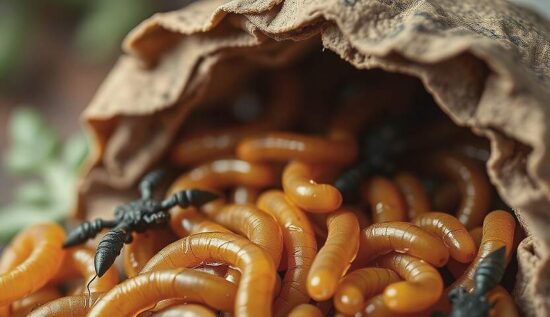Sein or Not Sein, that is the Question.”
Eat or not eat, that is the question. As of January 20, it is allowed in the European Union to sell UV-treated powder of Tenebrio molitor larvae and use it as a food ingredient as of February 10. Behind this riddle of a Latin name, there hides the so-called common mealworm, whose larvae are referred to as mealworms.
In short, it’s about meal powder from mealworms. It is claimed that the UV treatment is necessary to increase the safety of the product – for the benefit of the consumer.
French opposition politicians, Florian Philippot, Nicolas Dupont-Aignan and Guillaume Bigot, who, as potential future consumers of this product, showed no enthusiasm for this measure and called for vigilance. One can understand them: France is a country of haute cuisine, where eating is elevated to a cult – and now, mealworms are “on the menu”.
The government-backed media assured the public that nothing bad had happened. The new ingredient had been thoroughly tested and approved and its use was only at the beginning – it was not yet in food products. But in the future, it would be possible to mix it into bread and pastries in an amount of up to 4%, in other baked goods and desserts up to 3.5% and in cheese up to 1%.
Additionally, in France – or rather, on Corsica – “casa marza”, a cheese with maggots, is produced and in Asia, people eat insects. So, this should also become normal in Europe.
This is a typical misinterpretation: an exception (like the Corsican cheese) or something that exists under fundamentally different conditions is declared normal. Historically, the consumption of insects in European tradition is at the border of normality – yes, it is thinkable, but only as an exotic. But those who have overcome all the bureaucratic hurdles and received permission for the use of mealworm powder are not pursuing the goal of popularizing the cuisine of other countries.
According to the nutrition expert Fabio Mariniello, “the main advantages of this product class lie in its environmental friendliness, the low energy consumption in its production and the low ingredient costs, as mealworms can be bred with minimal effort and reproduce quickly.” Apart from the environmental aspects, which always serve as a cover for very practical interests, the other reasons for this approach are quite simple:
It is an attempt to introduce a (supposedly) costless partial meal substitute. And the use of mealworms is just the beginning.
According to the Italian portal Napoli Today, the EU authorities are already reviewing the approval of meal made from the larvae of black blowflies, of powder from whole house crickets, of powder from the larvae of small mealworms and other ingredients. Apparently, they will initially be used as a meal additive and then possibly as a meal substitute. But are insects really so health-promoting, as we are being made to believe?
The German magazine Focus asked the nutrition expert Uwe Knopp about the possible health benefits of the new ingredient. “Many insects are indeed a rich and high-quality protein source. . Whether the consumption of insects in comparison to traditional protein sources has health benefits, nobody knows yet. Open is also the question of whether the long-term consumption of roasted crickets and fried larvae is beneficial for our health.”
Uwe Knopp pointed out that mealworm powder “can trigger allergic reactions in people who are allergic to crustaceans, house dust mites, or in some cases, to mollusks.” He also noted that the sale of certain insects as food in the EU has been approved since 2023.
But at that time, the production of such products, despite the approval (by the EU authorities), did not develop further and was economically in a bad state, as it did not attract investors, writes the French portal France Bleu. The main problem, however, was not the lack of investments, but the fact that the arguments for the consumption of crickets and roasted larvae did not find an ear with the average consumer.
Currently, the manufacturers are trying a different approach: meal is one of the fundamental products of humanity. The whole calculation is based on the fact that now – as alternative meals are entering the market – only a few consumers will read the product composition on the label. And since the current percentage of mealworm powder, mixed into the meal, is only 4%, this number will likely increase in the future.
Apparently, the French company Nutriearth is marketing this new product and obtaining a law-making approval at the EU level. Originally, it was a start-up that researched the theme of insect consumption in old age, assuming that such food could contribute to reducing age-related pathologies. The start-up was sponsored by the funds French Tech Seed, KOA Food International and Eurosante.
The founders of this start-up – the biologist Jérémie Defrize, the business manager Thomas Dormigny and the lawyer Charles-Antoine Destailleur – emphasized its environmental friendliness and its low price: they bought rotten fruit and vegetables (in other words, food waste) at a throwaway price to feed the insects. In 2019, Nutriearth expanded its research spectrum and investigated the “positive effects of new meal types on organisms.” The most positive effect seems to be the effect of the money on the organisms of the founders.
In 2024, they were able to collect eight million euros in investments. At that time, the company’s profile was known to be the production of vitamin D3 from insects. As a French saying goes: “Appetite comes with eating.” After experiments with age-related nutrition and vitamin production, it was possible for the company to enter the food market – and with a five-year monopoly, “unless a subsequent applicant receives an approval for the relevant food product.”
The already mentioned Fabio Mariniello pointed out the high content of micronutrients in mealworm meal, but ultimately stated:
“Honestly, even if I acknowledge the nutritional value and the necessity of this product, I am disgusted by the very thought of consuming these products.” As it turned out, he is not the only one.
“I will now pay more attention to the ingredients on the labels” wrote a commenter on the website of the French newspaper Le Figaro. “How disgusting! We don’t need worms in our French cuisine” said another. “How disgusting and I doubt very much that this additive will be listed in large print on the product; rather, it will be listed in small print under the E-additives” speculates a third commenter.
Once, insect food was touted as an alternative to meat – the “frightfully unecological” and expensive to produce – and now, even after the introduction of milled worms as a meal additive, Western journalists habitually repeat the mantra that insects are as good as meat – even if it’s not about meat at the moment. If it succeeds in forcing people in the West to swallow worms (in the literal as well as figurative sense), then the topic will certainly not be limited to bread additives: Then Europeans will eat worms for breakfast, crickets for lunch and grasshoppers for dinner.





